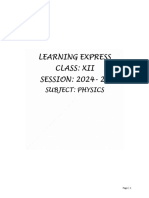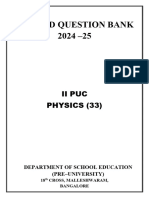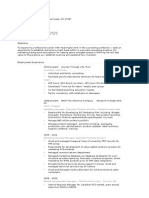0 ratings0% found this document useful (0 votes)
76 viewsClass 12 Physics Worksheet
Uploaded by
yashverma2786Copyright
© © All Rights Reserved
Available Formats
Download as PDF, TXT or read online on Scribd
0 ratings0% found this document useful (0 votes)
76 viewsClass 12 Physics Worksheet
Uploaded by
yashverma2786Copyright
© © All Rights Reserved
Available Formats
Download as PDF, TXT or read online on Scribd
You are on page 1/ 2
KANHA MAKHAN PUBLIC SCHOOL
CLASS XII SUBJECT- PHYSICS
UNIT – 01 ELECTRIC CHARGES AND FIELDS WORKSHEET
Multiple Choice Questions
1. A polythene piece rubbed with wool is found to have a negative charge of 8 x 10-10C. What is the number of
electrons transferred?
(a) 2 x 1010; polythene to wool (b) 5 x 109; polythene to wool
10
(d)2x 10 ; wool to polythene (c) 5 x 109; wool to polythene
2. A positively charged glass rod attracts an object. The object must be
(a) negatively charged (c) either negatively charged or neutral
(b) Neutral (d) a magnet
3. The number of electrons in one coulomb of electric charge is:
(a) 6.25x10-18 (b) 6.25x1018 (c) 1.6x10-19 (d) 1.6x1019
4. Two point charges +4 uC and -2 uC are placed at a certain distance in air. They experience an
attractive force F. If they are brought in contact with each other and then separated to the same distance, the
new repulsive force between them will be
(a) 8F (b) 4F (c)F/8 (d)F/4
5. Which of the following is not a property of charges?
(a) Quantisation (b) Additive
(c) Scalar (d) affected by frames of reference
6. Charged bodies are considered as point charges if the linear size of the charged bodies is
(a) Much smaller than the separation between them (b) Greater than the separation between them
(c) Equal to the separation between them (d) Independent of separation between them
7. The magnitude of the electric force exerted by a proton on an electron in hydrogen atom is (Given the distance
of separation between charges, 1A0)
(a) 2.3 x 10-10 N (b) 2.3 x 10-8N (c)2.3x 10-9N (d)2.3 x 10-7N
8. Magnitude of electric field due to a point charge + Q experienced by a test charge q at a distance r from point
charge +Q is equal to:
(a) Magnitude of electric force experienced by the point charge/Q
(b) Magnitude of electric force experienced by the test charge/q
(c) Magnitude of the repulsive force between the point charge and the test charge
(d) Magnitude of electric force experienced by point charge Q multiplied by the magnitude of charge
on the test charge
9. The magnitude of the electric field due to a point charge object at a distance of 4.0 m is 9 N/C. From the same
charged object, the electric field of magnitude, 16 N/C will be at a distance of
(a) 1 m (b) 2 m (c) 3 m (d) 6 m
10. An isolated point charge particle produces an electric field E at a point 3 m away from it. The
distance of the point at which the field is E/4 will be
(a) 2 m (b) 3 m (c) 4 m (d) 6 m
11. Select the most appropriate option from those given below each question :
If a positive charge is displaced against the electric field in which it was situated, then
(a) work will be done by the electric field on the charge.
(b) the intensity of the electric field decreases.
(c) energy of the system will decrease.
(d) energy will be provided by external source displacing the charge.
12. The point charges 5 x 10-11 C and - 5 x 10-11 C are placed along x-axis at x = 3 cm and x =-3 cm
respectively. What will be the electric field intensity at a point (0, 4) cm?
(a) 2.16 x 10-5 N/C (b) 2.16 x 102 N/C (c) 2.16 x 10-2 N/C (d) Zero
13. Statement I: Speed of a negatively charged particle decreases while moving in the direction of an electric field.
Statement II: A positively charged particle moving in the direction of an electric field experience
(a) Both statement I and statement II are true (b) Both statement I and statement II are false
(c) Statement I is true but statement II is false (d) Statement I is false but statement II is true
14. Two point charges qa = 3uC and qb =-3uC are located 2m apart in vacuum. The electric field at midpoint of the
line joining the two charges is
(a) 5.4 x 104 N/C (b) 1.35 x 104 N/C (c) 2.7 x 104 N/C (d) Zero
15. A point charge +q, is placed at a distance d from an isolated conducting plane. The field at a point P on the other
side of the plane is
(a) directed perpendicular to the plane and away from the plane.
(b) directed perpendicular to the plane but towards the plane.
(c) directed radially away from the point charge.
(d) directed radially towards the point charge.
16. If +σ and -σ are the uniform surface charge densities of two parallel infinite thin plane sheets, then the net
electric field at the mid-point of the two sheets will be given by
σ σ σ
a) 2εo b) – εo c) εo d) Zero
17. Gauss theorem states that ∮ ⃗⃗⃗ E. ⃗⃗⃗⃗
ds = 0. It means that
a) E is zero on the surface b) E is perpendicular to the surface
c) The total flux through the closed surface is zero d) The flux is only going out of the surface
18. Electric field at the surface, of a conducting shell of radius r is measured as X. Electric field at a distance 3r from
the centre of the shell is
a) X/3 b) X/6 c) X/9 d) X
19. Three point charges 4q, Q and q are placed in a straight line of length l as shown. The net force on charge q is
zero when value of q is –
a) –Q b) -2Q c) -Q/2 d) NOTA.
20. The electric flux through the surface
a) In fig. (iv) is the largest. b) In fig. (iii) is the least.
c) In fig. (ii) is same as fig.(iii)but is smaller than fig.(iv) d) Is the same for all the figures
SHORT ANSWER TYPE QUESTIONS
21. Write Coulomb’s law in vector form.
22. Explain why two electric field lines can’t intersect each other.
23. Draw the pattern of field lines due to a positive and a negative charge.
24. Draw the pattern of the field lines around a system of two equal positive charges separated by a small distance.
25. An arbitrary surface encloses a dipole. What is the electric flux through this surface?
26. Derive an expression for the intensity of an electric field due to a point charge.
27. Derive an expression for the torque on an electric dipole placed in a uniform electric field. Find the angle at
which torque is (i) maximum, (ii)minimum.
28. Define electric flux and state Gauss's theorem.
29. Derive an expression for an electric field due to a system of charges by the superposition principle.
LONG ANSWER TYPE QUESTIONS
30. Two point charges q1 = 1 x 10-6 C and q2 = 4 x 10-6 are placed 2 m apart in air. At what distance from q1 along
the line joining the two charges, will the net electric field be zero?
31. Three identical positive charges are placed at the corners of an equilateral triangle with side length a. What is
the net force acting on any one charge due to the other two?
32. A charge of 17.7 X 10-4 C is distributed uniformly over a large sheet of area 200 m2. Calculate the electric field
intensity at a distance of 20 cm from it in the air.
33. Two point charges of 2 x 10-7 C and 1 x 10-7 C are 1 cm apart. What is the magnitude of the field produced by
either charge at the site of the other?
34. An electric dipole consists of two opposite charges of magnitude 1/3 X 10-7 C, separated by 2 cm. The dipole is
placed in an external field of 3 X 107 N/C. What maximum torque does the electric field exert on the dipole?
35. The electrostatic force on a small sphere of charge 0.4 µC due to another small sphere of charge -0.8 µC in air is
0.2 N. What is the distance between two spheres?
36. Use Gauss' law to obtain an expression for the electric field due to an infinitely long thin straight wire with
uniform linear charge density 𝜆.
ii. An infinitely long positively charged straight wire has a linear charge density 𝜆. An electron is revolving in a
circle with a constant speed v such that the wire passes through the centre,
and is perpendicular to the plane, of the circle. Find the kinetic energy of the electron in terms of magnitudes of
its charge and linear charge density 𝜆 on the wire.
iii. Draw a graph of kinetic energy as a function of linear charge density.
37. Use Gauss’s theorem to find the electric field due to a uniformly charged infinitely large plane thin sheet with
surface charge density σ.
(b) An infinitely large thin plane sheet has a uniform surface charge density + σ. Obtain the expression for the
amount of work done in bringing a point charge q from infinity to a point, distance r, in front the charged plane
sheet.
You might also like
- PID Project Initiation Document Template PDF100% (1)PID Project Initiation Document Template PDF11 pages
- The Wyoming Legislature: A Citizen Guide To100% (1)The Wyoming Legislature: A Citizen Guide To24 pages
- Ultrix15 Questions - Class 12th PhysicsNo ratings yetUltrix15 Questions - Class 12th Physics145 pages
- Electric Charges and Field-QB Ans UR PartNo ratings yetElectric Charges and Field-QB Ans UR Part28 pages
- Ch I Electrostatics-Charges and Fields Assignment I 25-26No ratings yetCh I Electrostatics-Charges and Fields Assignment I 25-263 pages
- CLASS XII PHYSICS MCQS(CASE STUDY BASED QUESTIONS,AR,ADDITONAL QUESTIONS) (2)No ratings yetCLASS XII PHYSICS MCQS(CASE STUDY BASED QUESTIONS,AR,ADDITONAL QUESTIONS) (2)82 pages
- Questions: Cbse-English-Class 12-Physics-Chapter 2No ratings yetQuestions: Cbse-English-Class 12-Physics-Chapter 217 pages
- Mahapralay DPP - Electric Charges and FieldsNo ratings yetMahapralay DPP - Electric Charges and Fields9 pages
- Direction: Choose The Best Answer. Write The Letter Only.: General Physics 2 Long Quiz 1 DATENo ratings yetDirection: Choose The Best Answer. Write The Letter Only.: General Physics 2 Long Quiz 1 DATE11 pages
- Electric Charges & Electrostatics - 50 QsNo ratings yetElectric Charges & Electrostatics - 50 Qs8 pages
- Electric Field and Charge - Sankalp YashasNo ratings yetElectric Field and Charge - Sankalp Yashas4 pages
- Coulomb's Law, Electric Field & Potential (05!05!2024)No ratings yetCoulomb's Law, Electric Field & Potential (05!05!2024)6 pages
- KCET Physics 2025 Electirc Charges and Field top 30 PYQsNo ratings yetKCET Physics 2025 Electirc Charges and Field top 30 PYQs36 pages
- 12th Phase-1 Milestone Paper-1 _ Test Paper (ROI)No ratings yet12th Phase-1 Milestone Paper-1 _ Test Paper (ROI)18 pages
- Practice Sheet-01 - XII - JEE-NEET - PHY - Shiv Sir - MamtaNo ratings yetPractice Sheet-01 - XII - JEE-NEET - PHY - Shiv Sir - Mamta3 pages
- Electric Charge and Fields Assignment-3 (1)No ratings yetElectric Charge and Fields Assignment-3 (1)6 pages
- Electric Charges and Field: Very Short Answer Type Questions100% (1)Electric Charges and Field: Very Short Answer Type Questions4 pages
- Prashant Tutorials: MM-64. Physics Chap 1 & 2 Time1h.30min Electric Charges and Fields Class 12 Physics McqsNo ratings yetPrashant Tutorials: MM-64. Physics Chap 1 & 2 Time1h.30min Electric Charges and Fields Class 12 Physics Mcqs29 pages
- Chapter - 1: Electric Charges and FieldsNo ratings yetChapter - 1: Electric Charges and Fields7 pages
- Electron Beam-Specimen Interactions and Simulation Methods in MicroscopyFrom EverandElectron Beam-Specimen Interactions and Simulation Methods in MicroscopyNo ratings yet
- Vacuum Nanoelectronic Devices: Novel Electron Sources and ApplicationsFrom EverandVacuum Nanoelectronic Devices: Novel Electron Sources and ApplicationsNo ratings yet
- Analysis of Synchronous Generator Internal Insulation Failures100% (2)Analysis of Synchronous Generator Internal Insulation Failures5 pages
- Marine Pollution Assignment 2 Inc. Front SheetNo ratings yetMarine Pollution Assignment 2 Inc. Front Sheet2 pages
- Intel Architecture: 2.1. Brief History of The Ia-32 ArchitectureNo ratings yetIntel Architecture: 2.1. Brief History of The Ia-32 Architecture19 pages
- Standards For 7-Day and 28-Day Strength Test ResultNo ratings yetStandards For 7-Day and 28-Day Strength Test Result1 page
- Map Server For Visualizing Air Traffic Based On Data From A Remote Pseudo RadarNo ratings yetMap Server For Visualizing Air Traffic Based On Data From A Remote Pseudo Radar14 pages
- SMA 3261 - Lecture 4 - Numerical - DifferentiationNo ratings yetSMA 3261 - Lecture 4 - Numerical - Differentiation10 pages
- Review Notes in Working Papers Review Notes in Working PapersNo ratings yetReview Notes in Working Papers Review Notes in Working Papers16 pages
- Performance Review Toolkit - Tools, Tips, Templates, and MoreNo ratings yetPerformance Review Toolkit - Tools, Tips, Templates, and More41 pages
- 99.poultry Breeding and Multiplication Center OkNo ratings yet99.poultry Breeding and Multiplication Center Ok21 pages
- Reflective Practice Using Assessment DataNo ratings yetReflective Practice Using Assessment Data58 pages
- Sensors: Evolution of RFID Applications in Construction: A Literature ReviewNo ratings yetSensors: Evolution of RFID Applications in Construction: A Literature Review21 pages

























































































